[English] 日本語
 Yorodumi
Yorodumi- PDB-4n81: Another flexible region at the active site of an inositol monopho... -
+ Open data
Open data
- Basic information
Basic information
| Entry | Database: PDB / ID: 4n81 | ||||||
|---|---|---|---|---|---|---|---|
| Title | Another flexible region at the active site of an inositol monophosphatase from Zymomonas mobilis | ||||||
 Components Components | Inositol monophosphatase | ||||||
 Keywords Keywords | HYDROLASE | ||||||
| Function / homology |  Function and homology information Function and homology information | ||||||
| Biological species |  Zymomonas mobilis (bacteria) Zymomonas mobilis (bacteria) | ||||||
| Method |  X-RAY DIFFRACTION / X-RAY DIFFRACTION /  SYNCHROTRON / SYNCHROTRON /  MOLECULAR REPLACEMENT / Resolution: 1.901 Å MOLECULAR REPLACEMENT / Resolution: 1.901 Å | ||||||
 Authors Authors | Hwang, H.J. / Park, S.Y. / Kim, J.S. | ||||||
 Citation Citation |  Journal: Biochem.Biophys.Res.Commun. / Year: 2014 Journal: Biochem.Biophys.Res.Commun. / Year: 2014Title: Crystal structure of cbbF from Zymomonas mobilis and its functional implication Authors: Hwang, H.J. / Park, S.Y. / Kim, J.S. | ||||||
| History |
|
- Structure visualization
Structure visualization
| Structure viewer | Molecule:  Molmil Molmil Jmol/JSmol Jmol/JSmol |
|---|
- Downloads & links
Downloads & links
- Download
Download
| PDBx/mmCIF format |  4n81.cif.gz 4n81.cif.gz | 123.8 KB | Display |  PDBx/mmCIF format PDBx/mmCIF format |
|---|---|---|---|---|
| PDB format |  pdb4n81.ent.gz pdb4n81.ent.gz | 96.9 KB | Display |  PDB format PDB format |
| PDBx/mmJSON format |  4n81.json.gz 4n81.json.gz | Tree view |  PDBx/mmJSON format PDBx/mmJSON format | |
| Others |  Other downloads Other downloads |
-Validation report
| Summary document |  4n81_validation.pdf.gz 4n81_validation.pdf.gz | 436.7 KB | Display |  wwPDB validaton report wwPDB validaton report |
|---|---|---|---|---|
| Full document |  4n81_full_validation.pdf.gz 4n81_full_validation.pdf.gz | 438.1 KB | Display | |
| Data in XML |  4n81_validation.xml.gz 4n81_validation.xml.gz | 14.2 KB | Display | |
| Data in CIF |  4n81_validation.cif.gz 4n81_validation.cif.gz | 21.4 KB | Display | |
| Arichive directory |  https://data.pdbj.org/pub/pdb/validation_reports/n8/4n81 https://data.pdbj.org/pub/pdb/validation_reports/n8/4n81 ftp://data.pdbj.org/pub/pdb/validation_reports/n8/4n81 ftp://data.pdbj.org/pub/pdb/validation_reports/n8/4n81 | HTTPS FTP |
-Related structure data
| Related structure data |  4n89 |
|---|---|
| Similar structure data |
- Links
Links
- Assembly
Assembly
| Deposited unit | 
| ||||||||
|---|---|---|---|---|---|---|---|---|---|
| 1 | 
| ||||||||
| Unit cell |
| ||||||||
| Components on special symmetry positions |
|
- Components
Components
| #1: Protein | Mass: 28678.676 Da / Num. of mol.: 1 Source method: isolated from a genetically manipulated source Source: (gene. exp.)  Zymomonas mobilis (bacteria) / Strain: ZM4 / Gene: ZMO1518 / Production host: Zymomonas mobilis (bacteria) / Strain: ZM4 / Gene: ZMO1518 / Production host:  |
|---|---|
| #2: Chemical | ChemComp-SO4 / |
| #3: Water | ChemComp-HOH / |
-Experimental details
-Experiment
| Experiment | Method:  X-RAY DIFFRACTION / Number of used crystals: 1 X-RAY DIFFRACTION / Number of used crystals: 1 |
|---|
- Sample preparation
Sample preparation
| Crystal | Density Matthews: 3.12 Å3/Da / Density % sol: 60.57 % |
|---|---|
| Crystal grow | Temperature: 298 K / Method: vapor diffusion, hanging drop / pH: 8.5 Details: 11%(w/v) polyethylene glycol 4000, 0.2M Lithium sulfate, 0.1M Tris-HCl, pH 8.5, VAPOR DIFFUSION, HANGING DROP, temperature 298K |
-Data collection
| Diffraction | Mean temperature: 100 K |
|---|---|
| Diffraction source | Source:  SYNCHROTRON / Site: PAL/PLS SYNCHROTRON / Site: PAL/PLS  / Beamline: 6C1 / Wavelength: 1.2 Å / Beamline: 6C1 / Wavelength: 1.2 Å |
| Detector | Type: ADSC QUANTUM 315r / Detector: CCD / Date: Dec 8, 2008 |
| Radiation | Monochromator: GRAPHITE / Protocol: SINGLE WAVELENGTH / Monochromatic (M) / Laue (L): M / Scattering type: x-ray |
| Radiation wavelength | Wavelength: 1.2 Å / Relative weight: 1 |
| Reflection | Resolution: 1.9→50 Å / Num. all: 28603 / Num. obs: 28603 / % possible obs: 100 % / Observed criterion σ(F): 0 / Observed criterion σ(I): 0 / Biso Wilson estimate: 21.22 Å2 |
| Reflection shell | Resolution: 1.9→1.97 Å / % possible all: 100 |
- Processing
Processing
| Software |
| ||||||||||||||||||||||||||||||||||||||||||||||||||||||||||||||||||||||||||||||||||||||||||||||||||||||||||||||||||||||||||||||
|---|---|---|---|---|---|---|---|---|---|---|---|---|---|---|---|---|---|---|---|---|---|---|---|---|---|---|---|---|---|---|---|---|---|---|---|---|---|---|---|---|---|---|---|---|---|---|---|---|---|---|---|---|---|---|---|---|---|---|---|---|---|---|---|---|---|---|---|---|---|---|---|---|---|---|---|---|---|---|---|---|---|---|---|---|---|---|---|---|---|---|---|---|---|---|---|---|---|---|---|---|---|---|---|---|---|---|---|---|---|---|---|---|---|---|---|---|---|---|---|---|---|---|---|---|---|---|---|
| Refinement | Method to determine structure:  MOLECULAR REPLACEMENT / Resolution: 1.901→39.295 Å / Occupancy max: 1 / Occupancy min: 0.5 / FOM work R set: 0.9026 / SU ML: 0.16 / σ(F): 1.35 / Phase error: 16.14 / Stereochemistry target values: ML MOLECULAR REPLACEMENT / Resolution: 1.901→39.295 Å / Occupancy max: 1 / Occupancy min: 0.5 / FOM work R set: 0.9026 / SU ML: 0.16 / σ(F): 1.35 / Phase error: 16.14 / Stereochemistry target values: ML
| ||||||||||||||||||||||||||||||||||||||||||||||||||||||||||||||||||||||||||||||||||||||||||||||||||||||||||||||||||||||||||||||
| Solvent computation | Shrinkage radii: 0.9 Å / VDW probe radii: 1.11 Å / Solvent model: FLAT BULK SOLVENT MODEL | ||||||||||||||||||||||||||||||||||||||||||||||||||||||||||||||||||||||||||||||||||||||||||||||||||||||||||||||||||||||||||||||
| Displacement parameters | Biso max: 110.7 Å2 / Biso mean: 24.4505 Å2 / Biso min: 7.48 Å2 | ||||||||||||||||||||||||||||||||||||||||||||||||||||||||||||||||||||||||||||||||||||||||||||||||||||||||||||||||||||||||||||||
| Refinement step | Cycle: LAST / Resolution: 1.901→39.295 Å
| ||||||||||||||||||||||||||||||||||||||||||||||||||||||||||||||||||||||||||||||||||||||||||||||||||||||||||||||||||||||||||||||
| Refine LS restraints |
| ||||||||||||||||||||||||||||||||||||||||||||||||||||||||||||||||||||||||||||||||||||||||||||||||||||||||||||||||||||||||||||||
| LS refinement shell | Refine-ID: X-RAY DIFFRACTION / Total num. of bins used: 20 / % reflection obs: 100 %
| ||||||||||||||||||||||||||||||||||||||||||||||||||||||||||||||||||||||||||||||||||||||||||||||||||||||||||||||||||||||||||||||
| Refinement TLS params. | Method: refined / Origin x: 10.474 Å / Origin y: 39.9509 Å / Origin z: 27.5964 Å
| ||||||||||||||||||||||||||||||||||||||||||||||||||||||||||||||||||||||||||||||||||||||||||||||||||||||||||||||||||||||||||||||
| Refinement TLS group | Selection details: ALL |
 Movie
Movie Controller
Controller


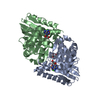
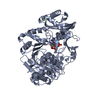
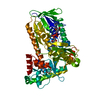
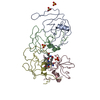
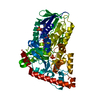
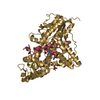
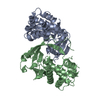
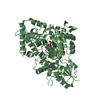
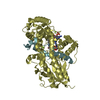
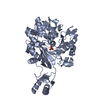
 PDBj
PDBj


